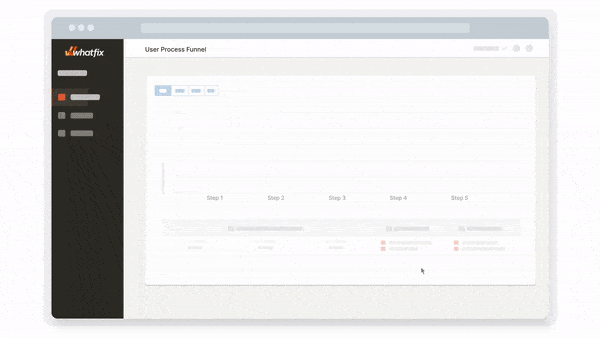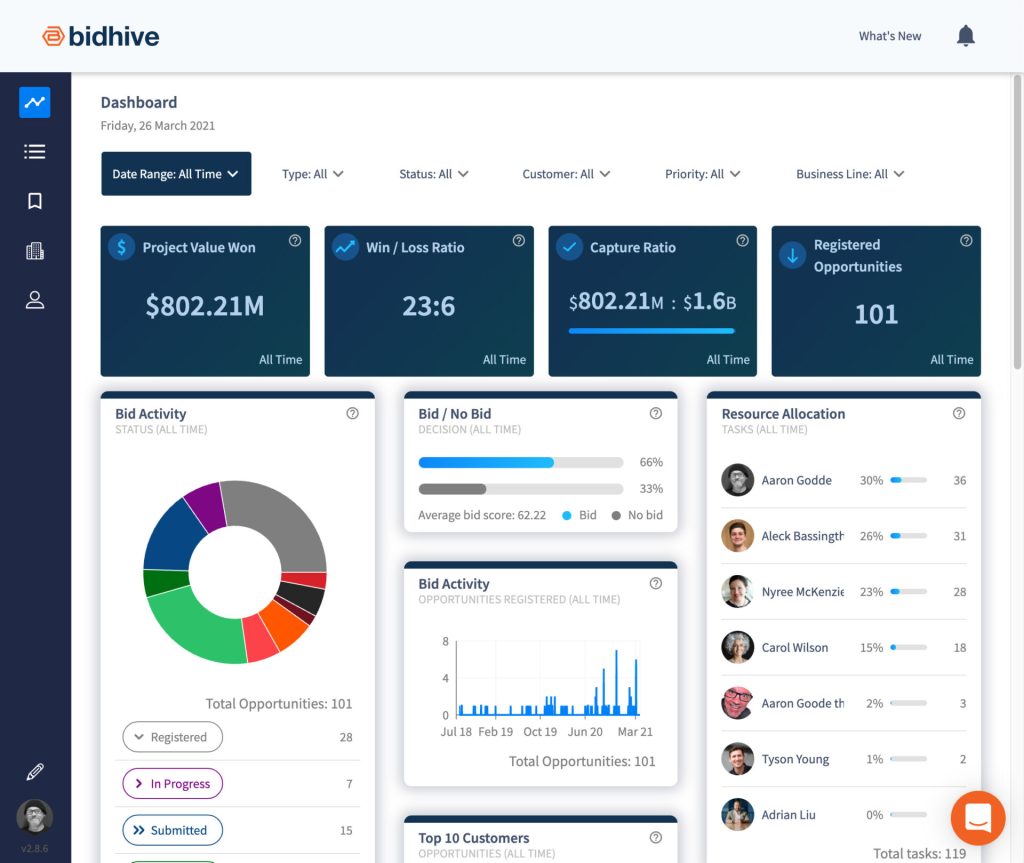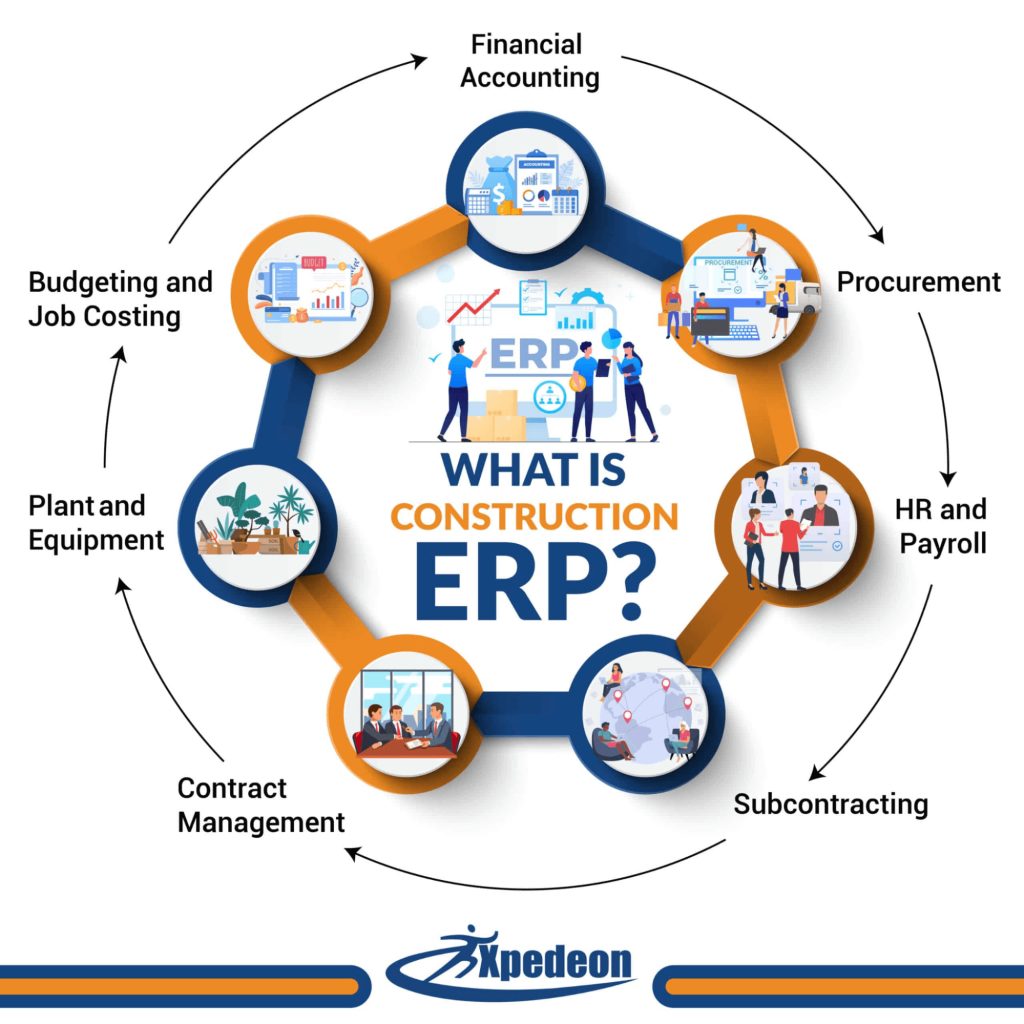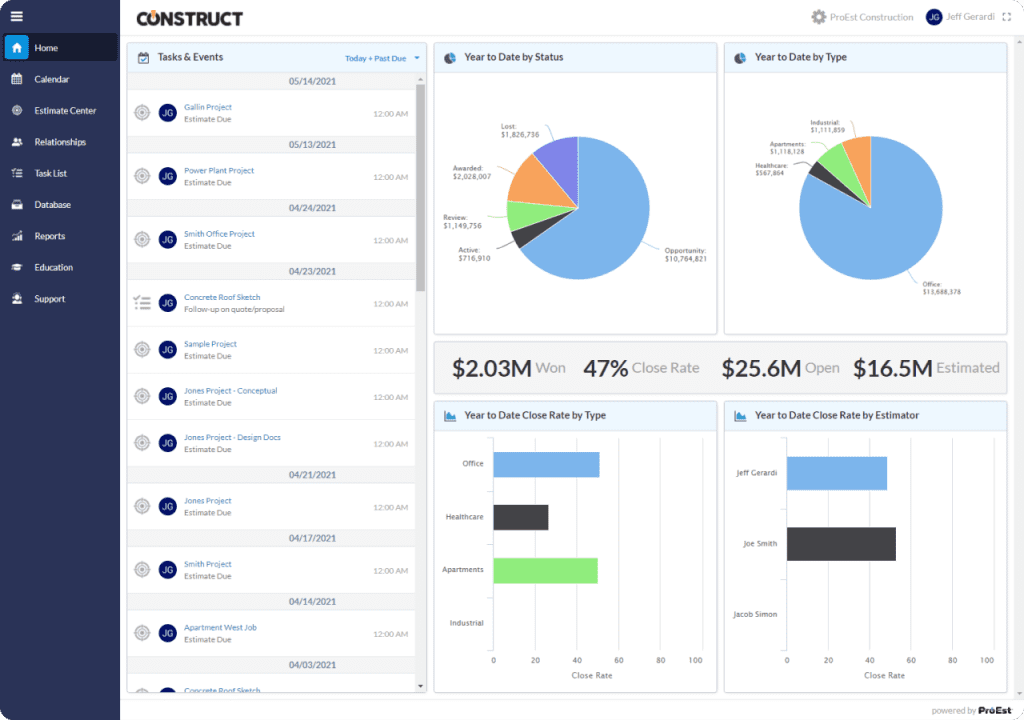
Digital Transformation in Construction (+Examples)
- Published:
- Updated: May 28, 2024

Construction companies face growing pressure to embrace new technologies and modernize tools and processes. Otherwise, they fall behind rising client expectations or losing bids to competitors. However, according to McKinsey, the architecture, engineering, and construction (AEC) industry has been among the slowest to digitize and innovate.
Many factors make digital transformation in this space complex, but it’s possible with the right approach. True transformation requires changing how construction professionals operate, provide value, and deliver better experiences across projects.
This article will explore the impacts of digital transformation in construction. First, we’ll cover the benefits of these initiatives. We’ll also discuss common hurdles around digital adoption and how to support lasting change. Plus, we’ll showcase real-world examples of digital tools elevating construction outcomes across the project lifecycle.
What Is Digital Transformation in Construction?
Digital transformation in construction refers to the intelligent implementation of technologies, from 3D modeling software to IoT sensors on equipment. Cloud platforms also connect these solutions, offering construction companies centralized access to project data analytics and shared services.
Collectively, these technologies provide visibility across the project lifecycle, from initial building plans to on-site execution. The connected construction ecosystem enhances communication workflows, materials tracking, and productivity benchmarking. As innovative tools like AI and AR mature, they will bring even more opportunities for improvement.
Benefits of Digitalization in the Construction Sector
Here are a few of the most critical benefits for the construction space.
1. Improved safety and risk management
Wearable sensors can detect hazardous conditions in real-time, reducing injuries. Connecting all data sources can go further to help with risk management, as construction professionals can get visibility into potential issues before they ever come up.
For example, a study done by one company offering digital transformation solutions for construction shows that usage of their product is correlated with a 40% lower incident rate and a 39% lower lost days rate compared to the construction industry average.
2. Reduced costs
Optimized resource planning, materials tracking, and reporting analytics empower construction firms to keep track of budgets across capital projects. By cutting wasted spend, minimizing errors, and boosting productivity, digitization can help construction organizations protect their bottom line.
Anywhere construction firms can cut costs is critical as expenses rise in other areas of the business. Construction machinery and equipment costs increased by 6% year over year in August, and by over 26% since February 2020.
3. Streamlined processes and improved operational efficiency
Digital solutions can refine processes across construction operations, creating better experiences for everyone involved. Research by the McKinsey Global Institute indicates that digital transformation can result in up to 15% productivity gains.
For example, building information modeling (BIM) software enables collaborative design and planning, while integrated project management platforms connect procurement workflows. These tools pave the way for greater visibility and coordination across teams.
During projects, progress dashboards offer better oversight to construction managers. By tracking schedules, equipment, and document workflows, managers can make decisions to optimize resource allocation. These changes to resource use and communication reduce delays and rework.
4. Better customer experience
Digitalization also bridges information gaps with clients, which changes the way they interact with organizations and their experience overall. It’s clear that companies are taking notice, as nearly all CX leaders have invested or plan to invest in data integration, data integrity, or data enrichment technologies.
For example, virtual reality solutions allow visualization at all stages, which gives them visibility into creative or technical details. This connectivity enhances alignment between final designs and client expectations. It also strengthens trust by opening clear lines of communication between the company and the client.
5. Increased collaboration
All participants in the project lifecycle from architects to engineers to customers can connect to the same platforms to exchange insights on progress or creative feedback. This allows construction companies to minimize miscommunication and deliver more projects successfully.
This is increasingly important, as one study by Gartner shows that after the first 18 months of the pandemic, 80% of workers reportedly used digital collaboration tools, up from 40% at the start of 2020. These numbers are likely to continue to rise.
Digital Transformation Challenges in the Construction Industry
Digital transformation can drive positive change in the construction space, but it also comes with its own set of pitfalls. Here are some common digital transformation challenges and specific strategies to overcome them.
1. Regulatory compliance
As digital transformation reshapes construction processes, companies must ensure that innovations align with relevant safety, quality, and data governance mandates. This is a balancing act, and there’s no one-size-fits-all answer. Many factors determine what specific regulations impact your operations, including the solutions you use.
For example, many construction companies can benefit from adding IoT devices. However, local data privacy and system security regulations may apply to these tools. Organizations with IoT in their digitization strategy should invest in robust cybersecurity infrastructure, internal training, and third-party risk assessments.
2. Managing decentralized teams
The decentralization and distributed nature of work is a big reason why digital transformation is valuable to modern organizations. However, this also creates complexity around maintaining data quality, access controls, and versioning.
Construction firms must implement robust collaborative software and project governance to synchronize insights across decentralized teams. Adding use guidelines and access policies will also help users embrace change while avoiding confusion, and you can enlist the help of a digital transformation consultant to help you build these guidelines.
3. Reskilling institutional knowledge
As veteran employees retire, valuable experience exits with them, spotlighting skills gaps and the need for upskilling. Due to a lack of qualified candidates available, 68% of construction firms surveyed by Deloitte need help to fill open positions. To meet the incoming demand for work, 69% of surveyed firms expect to increase headcount in the next year.
Construction firms can overcome this by including institutional knowledge in onboarding programs and introducing mentoring initiatives. An approach focusing on preserving existing expertise and adding information into new systems will help organizations adapt.
4. Poor data management
The volume of project information generated on each job demands controlled and secure access to data. Failure to implement reliable data management threatens transparency and exposes firms to compliance risks.
This isn’t something that firms can afford to ignore, as one study from Autodesk and FMI estimates that bad data causes the construction industry. $1.8 trillion in losses worldwide. Integrations with collaboration software, equipment sensors, and other tools should meet strict access protocols and change tracking requirements to avoid this loss level.
5. Contextual end-user enablement
Technology alone can’t drive transformation. Construction companies must enable end-user adoption through role-based education programs and simplified digital interfaces. Training should showcase features while contextualizing real-world applications and value.
Well-planned change management allows companies to reinforce digital transformation goals with staff over time. Tracking software usage patterns and user feedback is vital to making sense of adoption rates and ROI.
With Whatfix’s digital adoption platform (DAP), enable your technology end-users with contextual in-app guidance and moment-of-need support. With Whatfix’s no-code Visual Editor, non-technical team members can create in-app experiences that engage users and provide assistance in the flow of work.

With Whatfix, create:
- Tours and Task Lists to contextually onboard new end-users to legal technology with a guided experience.
- Flows that take end-users step-by-step through their tasks and help drive the adoption of complex, multi-step workflows through in-app training.
- Smart Tips that provide additional support and relevant information at the moment of need.
- Pop-Ups to make company announcements, remind employees of upcoming deadlines, drive awareness of new features or process changes, and more.
- In-app Surveys to capture feedback from construction firm employees and customers interacting with your digital experiences.

6. Identifying digital friction
Behind any technology integration, there are opportunities for improvements by identifying areas of digital friction in your processes. But you have to know where to look. By regularly reviewing the challenges users are having, you can identify feature gaps and optimize integrations over time.
With Whatfix, track and analyze end-user behavior with User Actions. This empowers legal IT teams to identify areas of end-user friction, map optimal user flows, build flows for different user cohorts, and more. Use this data to create new in-app guidance and end-user support content and continuously optimize and test new workflows and features to create more efficient, user-friendly technology experiences that drive value.

Examples of Digital Transformation In Construction
Many digital tools and technologies can help with different aspects of construction projects, enhancing efficiency, collaboration, and success. Here’s a closer look at some solutions construction companies implement as part of their digital transformation plan.
1. Bid management software
Bid management software streamlines the manual bid planning process. These solutions enable centralized collaboration, document accessibility, and data analytics. All to help contractors prepare more accurate, competitive proposals.
By consolidating insights across teams and past bids, the tools improve resource forecasting while reducing lost labor hours by sorting through outdated information. The optimized process increases quality and convenience in a crucial phase of construction.
For example, Bidhive removes data silos and connects the flow of information. This introduces a more manageable approach across the bid lifecycle to help companies become more efficient and successful in matching project contract profiles to their capability and risk position.

2. Construction ERP platforms
Construction ERPs (Enterprise Resource Planning Platforms) integrate previously disjointed systems from project management and HR to equipment management and accounting. Since these platforms are Accessible via web and mobile, all users gain visibility into data. With integrated dashboards and reports aggregating insights about schedules, costs, site events, teams can improve decision-making.
For example, BRIX is a fully integrated enterprise resource platform that allows home builders to access the most efficient solutions available for any size and volume. It lets you control job costing, purchasing, production, accounting, and reporting all in one place.

3. Jobsite management software
Jobsite software features daily activity logging, inventory tracking, document management, and real-time progress syncing. This level of connectivity allows offsite construction personnel and project owners to maintain an open line of communication and increase transparency.
For example, Procore provides a method of communication that improves how Avila’s project teams communicate. With Procore Conversations, any project team member can link a Procore project item directly to a communication thread. The ability to link directly to project items inside of Procore ensures the entire team references the most up-to-date and accurate project information. With the right information, teams can make the best decisions on the go, ultimately decreasing rework.

4. Construction CRM software
CRM solutions centralize all client, bid, and project data to power personalized engagements. Features range from automated sales follow-ups to document-sharing portals and self-service case logging for project issues.
For example, Alston wanted to bring sales and customer service up to the same high standards as the rest of the company. They used Prophet CRM embedded directly into Microsoft Outlook to synchronize and update the team’s native Outlook contacts, calendars, and functions. This made adoption much easier.

5. Client and customer portals
Client portals offer real-time visibility into project developments, milestones, and documentation. Easy access to status dashboards, progress photos, and invoices goes a long way toward building trust. They also cut down on the time professionals spend tracking documents or trading messages with customers.
Chris Ledet Homes provides a more modern and seamless client experience with Buildertrend. they’re now able to complete more homes per year. They could keep a leaner team but add more work because the home builder software gives them at least 40 hours per week in time savings, largely by speeding up communication.
6. Material takeoff software
Advanced MTO (material takeoff) solutions use digital blueprints to extract and estimate build material volumes. Automating this crucial planning activity minimizes costly overages and shortages while expediting the procurement timeline.
The time savings one company achieved using The EDGE was transparent. Before implementation estimating on a single project could take several months and require multiple people to complete. The company was able to cut the time spent on these tasks in half.

7. HR technology
Construction comes with unique workforce management challenges, like changes in hiring cycles as requirements shift. HR platforms help firms adapt by adding automation to recruiting, onboarding, training administration, and retention tracking. These tools can also provide analytics on labor patterns and skills gaps to forecast hiring needs.
With Team Engine, Ritsema Associates can let employees know they’re looking for referrals. Since employees receive that request via text, it’s fast and easy for them to submit their referral’s contact information right away. All of those submissions are then automatically stored and tracked to keep recommendations accessible.
8. Building information modeling
BIMs are virtual modeling software that allows collaborators to collectively visualize, test, or simulate design-build concepts in detail. The single source of truth drives informed planning. BIM software often links to other core solutions, including project management tools. This supports an intelligent and connected construction software stack.
For example, Autodesk offers cloud-based design co-authoring, collaboration, and coordination software for architecture, engineering, and construction teams. It enables anytime, anywhere collaboration to keep everyone on the same page.
Digital transformation is challenging, costly, resource-intensive, and has lengthy implementation and migration cycles. To make matters more complicated, every digitization project is different, even when comparing two construction companies.
Accelerate your construction company’s digital transformation by enabling your staff and clients with contextual in-app guidance and real-time support with Whatfix’s digital adoption platform (DAP).
Whatfix provides construction companies with a no-code editor to create in-app, moment-of-need support and contextual guidance on process changes. This reduces time-to-proficiency and achieves new levels of productivity and proficiency through better software adoption, as well as provides clients with self-service, personalized, and guided user experiences.
Whatfix empowers construction organizations to:
- Create in-app Flows and Task Lists that guide employees and clients step-by-step through digital processes and applications.
- Enable end-users with Self Help, providing a searchable help wiki that connects to all your help and support documentation, FAQs, help desk articles, and more – that overlays on your digital UI.
- Notify end-users of application process updates, compliance changes, company announcements, and more with Pop-Ups and Beacons.
- Provide contextual Smart Tips that enable end-users with timely information that nudges users to take the correct in-app action.
- Use Field Validation to ensure data is entered in full, in the correct format.
- Collect end-user feedback such as NPS, training and onboarding feedback, and bug identification with In-App Surveys.
- Analyze end-user behavior with User Actions and Enterprise Insights by tracking custom in-app events to optimize user journeys, segment users into cohorts, identify areas of friction, and more.
With Whatfix, you can understand how technology is being used and what is being underused. This makes it easier to adjust software training and adoption strategies. All to empower employees and clients to maximize the value of digital tools and move through the entire construction lifecycle with ease.

Thank you for subscribing!

